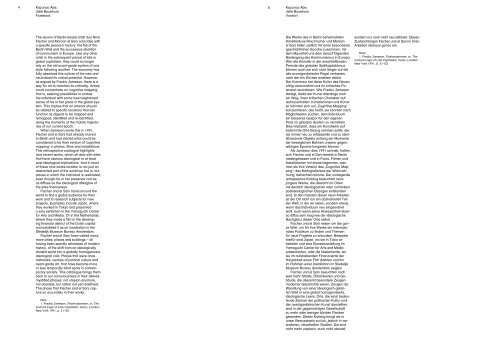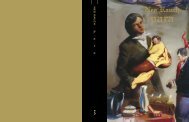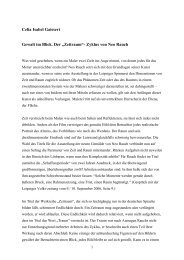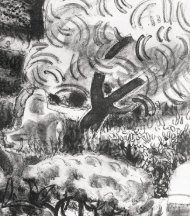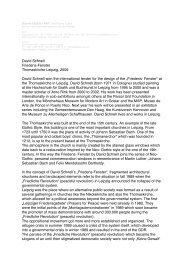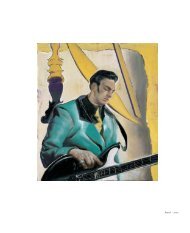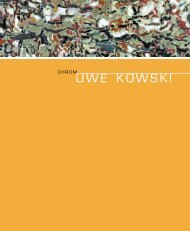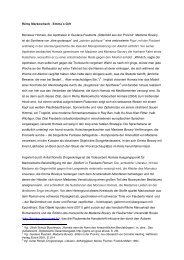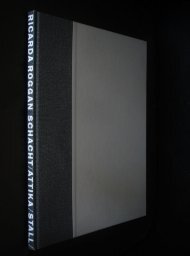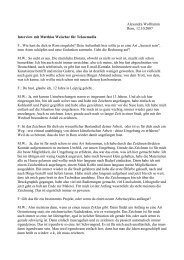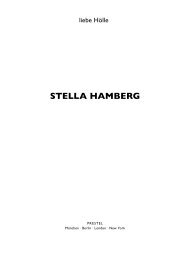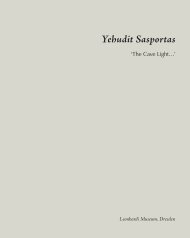Nina Fischer & Maroan el Sani Blind Spots
Nina Fischer & Maroan el Sani Blind Spots
Nina Fischer & Maroan el Sani Blind Spots
Sie wollen auch ein ePaper? Erhöhen Sie die Reichweite Ihrer Titel.
YUMPU macht aus Druck-PDFs automatisch weboptimierte ePaper, die Google liebt.
4<br />
Kazunao Abe,<br />
J<strong>el</strong>le Bouwhuis<br />
Foreword<br />
The œuvre of Berlin-based artist duo <strong>Nina</strong><br />
<strong>Fischer</strong> and <strong>Maroan</strong> <strong>el</strong> <strong>Sani</strong> coincides with<br />
a specific period in history: the fall of the<br />
Berlin Wall and the successive abolition<br />
of communism in Europe. Like any other<br />
artist in the subsequent period of late or<br />
global capitalism, they could no longer<br />
r<strong>el</strong>y on the old avant-garde system of one<br />
style following another. The economy has<br />
fully absorbed this culture of the new and<br />
neutralized its critical potential. However,<br />
as argued by Fredric Jameson, there is a<br />
way for art to maintain its criticality. Artists<br />
could concentrate on ‘cognitive mapping’,<br />
that is, seeking possibilities to endow<br />
the individual with some new heightened<br />
sense of his or her place in the global system.<br />
This implies that an artwork should<br />
be r<strong>el</strong>ated to specific locations that can<br />
function as objects to be mapped and<br />
remapped, identified and re-identified,<br />
along the moments of the mobile trajectories<br />
of our current epoch. 1<br />
When Jameson wrote this in 1991,<br />
<strong>Fischer</strong> and <strong>el</strong> <strong>Sani</strong> had already moved<br />
to Berlin and had started what could be<br />
considered to be their version of ‘cognitive<br />
mapping’ in photos, films and installations.<br />
This retrospective catalogue highlights<br />
nine recent works, which all deal with sites<br />
that have obvious ideological or at least<br />
post-ideological implications. And in most<br />
of these nine works location is not just an<br />
abstracted part of the world we live in, but<br />
places in which the individual is resituated,<br />
even though his or her presence can be<br />
as diffuse as the ideological afterglow of<br />
the sites thems<strong>el</strong>ves.<br />
<strong>Fischer</strong> and <strong>el</strong> <strong>Sani</strong> trav<strong>el</strong> around the<br />
world to find a global audience for their<br />
work and to research subjects for new<br />
projects. Examples include Japan, where<br />
they worked in Tokyo and presented<br />
a solo exhibition in the Yamaguchi Center<br />
for Arts and Media. Or in the Netherlands,<br />
where they made a film in the dev<strong>el</strong>oping<br />
financial district of the Dutch capital<br />
and exhibited it as an installation in the<br />
Sted<strong>el</strong>ijk Museum Bureau Amsterdam.<br />
<strong>Fischer</strong> and <strong>el</strong> <strong>Sani</strong> have visited many<br />
more cities, places and buildings – all<br />
having been specific witnesses of modern<br />
history, of the shift from an ideologically<br />
divided world into a globally homogenized,<br />
ideological void. Places that were once<br />
hallmarks, centres of political culture and<br />
avant-garde art, that have become more<br />
or less temporally blind spots in contemporary<br />
society. This catalogue brings them<br />
back to our consciousness in their altered,<br />
mystified phases: not utopian anymore,<br />
not obsolete, but rather not yet redefined.<br />
The phase that <strong>Fischer</strong> and <strong>el</strong> <strong>Sani</strong> capture<br />
so accurat<strong>el</strong>y in their works.<br />
Note<br />
1. Fredric Jameson, Postmodernism, or, The<br />
Cultural Logic of Late Capitalism, Verso, London/<br />
New York 1991, p. 51–52.<br />
5<br />
Kazunao Abe,<br />
J<strong>el</strong>le Bouwhuis<br />
Vorwort<br />
Die Werke des in Berlin beheimateten<br />
Künstlerduos <strong>Nina</strong> <strong>Fischer</strong> und <strong>Maroan</strong><br />
<strong>el</strong> <strong>Sani</strong> fallen zeitlich mit einer besonderen<br />
geschichtlichen Epoche zusammen: mit<br />
dem Mauerfall und dem darauf folgenden<br />
Niedergang des Kommunismus in Europa.<br />
Wie alle Künstler in der anschließenden<br />
Periode des globalen Spätkapitalismus<br />
können auch sie sich nicht länger auf die<br />
alte avantgardistische Reg<strong>el</strong> verlassen,<br />
nach der ein Stil den anderen ablöst.<br />
Der Kommerz hat diese Kultur des Neuen<br />
völlig vereinnahmt und ihr kritisches Potenzial<br />
neutralisiert. Wie Fredric Jameson<br />
darlegt, bleibt der Kunst allerdings noch<br />
ein Weg, ihren kritischen Charakter aufrechtzuerhalten.<br />
Künstlerinnen und Künstler<br />
könnten sich auf „Cognitive Mapping“<br />
konzentrieren, das heißt, sie könnten nach<br />
Möglichkeiten suchen, dem Individuum<br />
ein besseres Gespür für den eigenen<br />
Platz im globalen System zu vermitt<strong>el</strong>n.<br />
Dies impliziert, dass ein Kunstwerk auf<br />
bestimmte Orte Bezug nehmen sollte, die<br />
als immer neu zu erfassende und zu identifizierende<br />
Objekte entlang der Momente<br />
der beweglichen Bahnen unserer gegenwärtigen<br />
Epoche fungieren können. 1<br />
Als Jameson dies 1991 schrieb, hatten<br />
sich <strong>Fischer</strong> und <strong>el</strong> <strong>Sani</strong> bereits in Berlin<br />
niederg<strong>el</strong>assen und in Fotos, Filmen und<br />
Installationen mit etwas begonnen, was<br />
man als ihre Version des „Cognitive Mapping“,<br />
des Kartografierens der Wahrnehmung,<br />
betrachten könnte. Der vorliegende<br />
retrospektive Katalog b<strong>el</strong>euchtet neun<br />
jüngere Werke, die allesamt an Orten<br />
mit deutlich ideologischen oder zumindest<br />
postideologischen Bezügen entstanden<br />
sind. In den meisten dieser neun Arbeiten<br />
ist der Ort nicht nur ein abstrahierter Teil<br />
der W<strong>el</strong>t, in der wir leben, sondern etwas,<br />
worin das Individuum neu eingeordnet<br />
wird, auch wenn seine Anwesenheit ebenso<br />
diffus sein mag wie der ideologische<br />
Nachglanz dieser Orte s<strong>el</strong>bst.<br />
<strong>Fischer</strong> und <strong>el</strong> <strong>Sani</strong> reisen um die ganze<br />
W<strong>el</strong>t, um für ihre Werke ein internationales<br />
Publikum zu finden und Themen<br />
für neue Projekte zu erkunden. Beispi<strong>el</strong>e<br />
hierfür sind Japan, wo sie in Tokio arbeiteten<br />
und eine Einz<strong>el</strong>ausst<strong>el</strong>lung im<br />
Yamaguchi Center for Arts and Media<br />
präsentierten, oder die Niederlande, wo<br />
sie im aufstrebenden Finanzviert<strong>el</strong> der<br />
Hauptstadt einen Film drehten und ihn<br />
im Rahmen einer Installation im Sted<strong>el</strong>ijk<br />
Museum Bureau Amsterdam zeigten.<br />
<strong>Fischer</strong> und <strong>el</strong> <strong>Sani</strong> besuchten noch<br />
weit mehr Städte, Örtlichkeiten und Gebäude,<br />
die allesamt besondere Zeugen<br />
moderner Geschichte waren, Zeugen der<br />
Wandlung von einer ideologisch geteilten<br />
W<strong>el</strong>t in eine global homogenisierte,<br />
ideologische Leere. Orte, die einst bedeutende<br />
Zentren der politischen Kultur und<br />
der avantgardistischen Kunst darst<strong>el</strong>lten,<br />
sind in der gegenwärtigen Ges<strong>el</strong>lschaft<br />
zu mehr oder weniger blinden Flecken<br />
geworden. Dieser Katalog bringt sie in<br />
unser Bewusstsein zurück, jedoch in veränderten,<br />
räts<strong>el</strong>haften Stadien: Sie sind<br />
nicht mehr utopisch, auch nicht obsolet,<br />
sondern nur noch nicht neu definiert. Diesen<br />
Zustand fangen <strong>Fischer</strong> und <strong>el</strong> <strong>Sani</strong> in ihren<br />
Arbeiten überaus genau ein.<br />
Notiz<br />
1. Fredric Jameson, Postmodernism, or, The<br />
Cultural Logic of Late Capitalism, Verso, London/<br />
New York 1991, S. 51–52.


